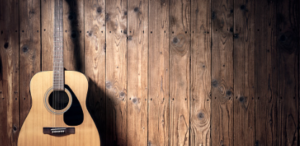Acoustic guitars sound fantastically unplugged; their hollow bodies act as Helmholtz resonators to enhance or reduce sound at different frequencies.
This kind of guitar is ideal for anyone who desires luscious chords and a beautiful tone, making it the ideal companion to accompany vocalists. Additionally, its flexible nylon strings lend themselves perfectly to fingerpicking techniques.
Body and Neck
An acoustic guitar’s hollow body transmits vibrations from its strings into the surrounding air and produces its sound, with larger bodies producing fuller-sounding notes while smaller bodies offer more targeted tones.
The neck is a long piece of wood that supports the fingerboard and frets of a guitar instrument, enabling its playing by guitarists. It may be curved or tapered into various forms and made of wood, such as ebony and rosewood. Furthermore, its design includes a notched area called the “nut”, which holds strings. Notches made from harder materials such as ivory or ebony produce higher frequencies, while those carved from soft wood produce lower ones.
A neck is reinforced with a truss rod to maintain tune and rigidity. The type of wood used has an immense influence on tone and sustain; heavier species like ebony, wenge, rosewood and oak provide more rigidity and darker tones than lighter mahogany and maple varieties. Many luthiers and makers are also experimenting with exotic species like ziricote, katalox and manchinge for greater rigidity and less weight.
Fretboard
Studio1 acoustic guitar can be composed of ebony, rosewood or maple and features frets (small metal rods) that create musical notes on each string. Frets are spaced evenly and increase pitch as you progress up the neck, narrowing logarithmically at higher frets.
 Fretboards feature inlaid decorative patterns called rosettes that range from simple and elegant to intricate designs. Guitar builders may select specific rosette patterns to differentiate their brand of guitars from others in the market.
Fretboards feature inlaid decorative patterns called rosettes that range from simple and elegant to intricate designs. Guitar builders may select specific rosette patterns to differentiate their brand of guitars from others in the market.
Learning each note on a fretboard takes time, but there are ways to shorten that learning process. One such method involves using octave shapes – patterns that link any given note with its respective octave shape (for instance, any C can be identified using six distinct locations on the fretboard as shown in FIGURE 4); they repeat themselves one octave higher beginning at the 12th fret.
Once you master this pattern, playing any string in standard tuning should become second nature. Apply this same approach to other string pairs – remember that the same letter names correspond to each octave; thus, a note on string two that appears at the fifth fret of first string will have its counterpart on string five with the same name. Counting frets between notes is also helpful for quickly locating their positions on the fretboard.
Bridge
Studio1 acoustic guitar is a critical component of the instrument. They hold strings in place while also helping determine their tuning; most often composed of either ebony or rosewood and attached directly to its top, these structures feature pin holes where strings attach; their location determines string spacing and intonation for optimal playback.
Some rare acoustic guitar models employ a variation on the fixed bridge known as a grooved ebony or rosewood bridge, which differs from its conventional version by featuring a groove where each string passes, with its saddle sitting inside this groove. It allows different vibrational frequencies for strings than with standard fixed bridges, creating more distinct tones from each string vibrating through.
If your acoustic guitar’s bridge needs replacing, the process can be performed at home with just a few simple tools and patience. A deep C-clamp works great as a clamp to secure it securely while performing a dry run by gently clamping. A dampened clean rag should also be handy to wipe away any extra glue seeping out as the clamp tightens to help prevent too much setting too quickly and causing unwanted structural changes to the instrument.
Pickups
Pickups convert string vibrations to electrical audio signals that can be amplified. Numerous styles suit various guitar models, installation methods and playing styles.
Studio1 acoustic guitar offers a naturalistic sound performance and is suitable for most play styles; however, fingerstyle players will benefit most. The discreet preamp controls pickup element control, mic trim adjustment and phase inversion, and battery check mode, so you’re always sure everything’s running smoothly.